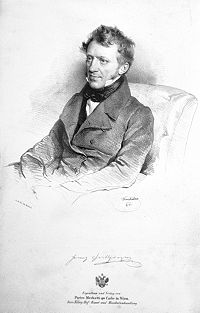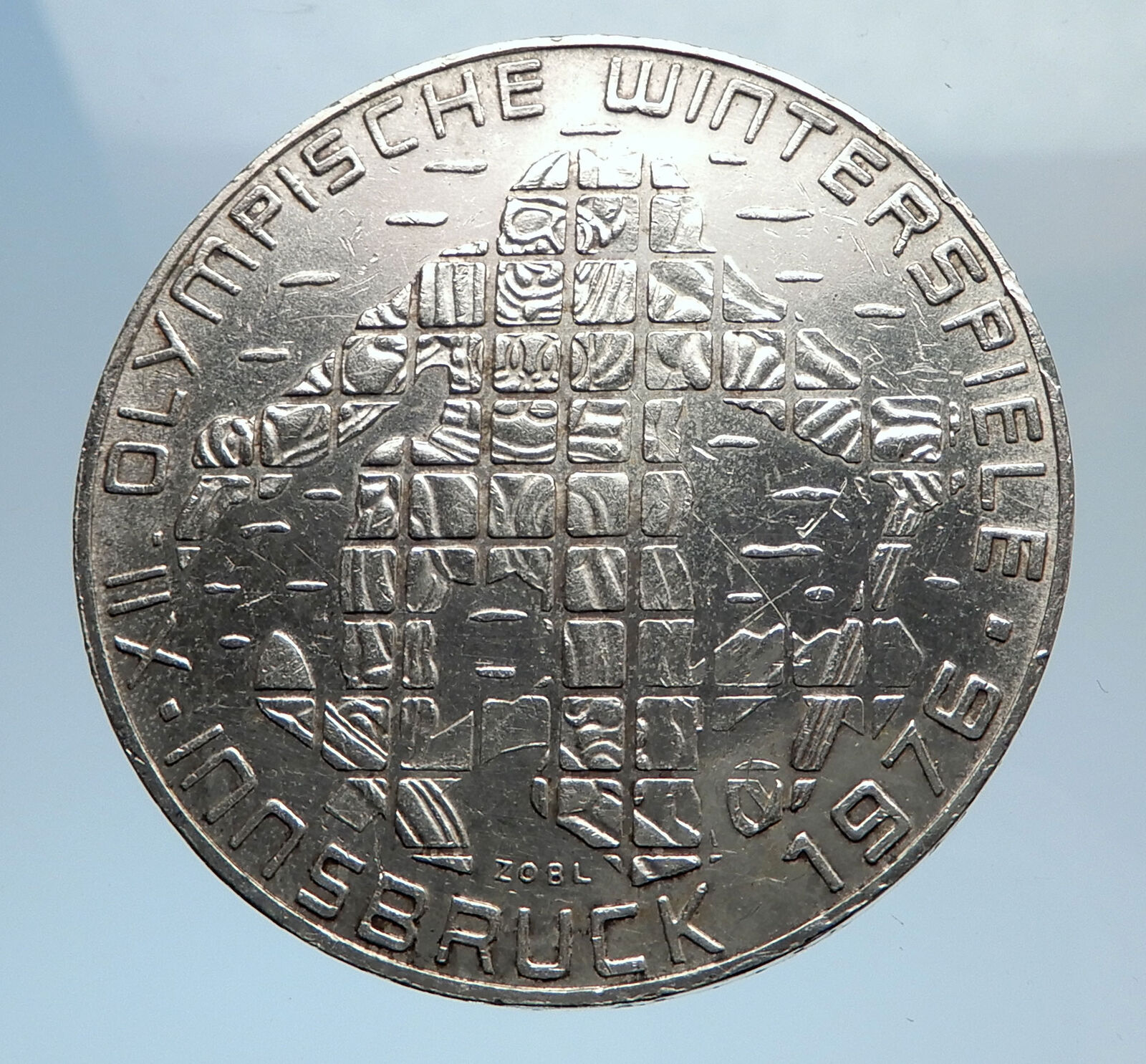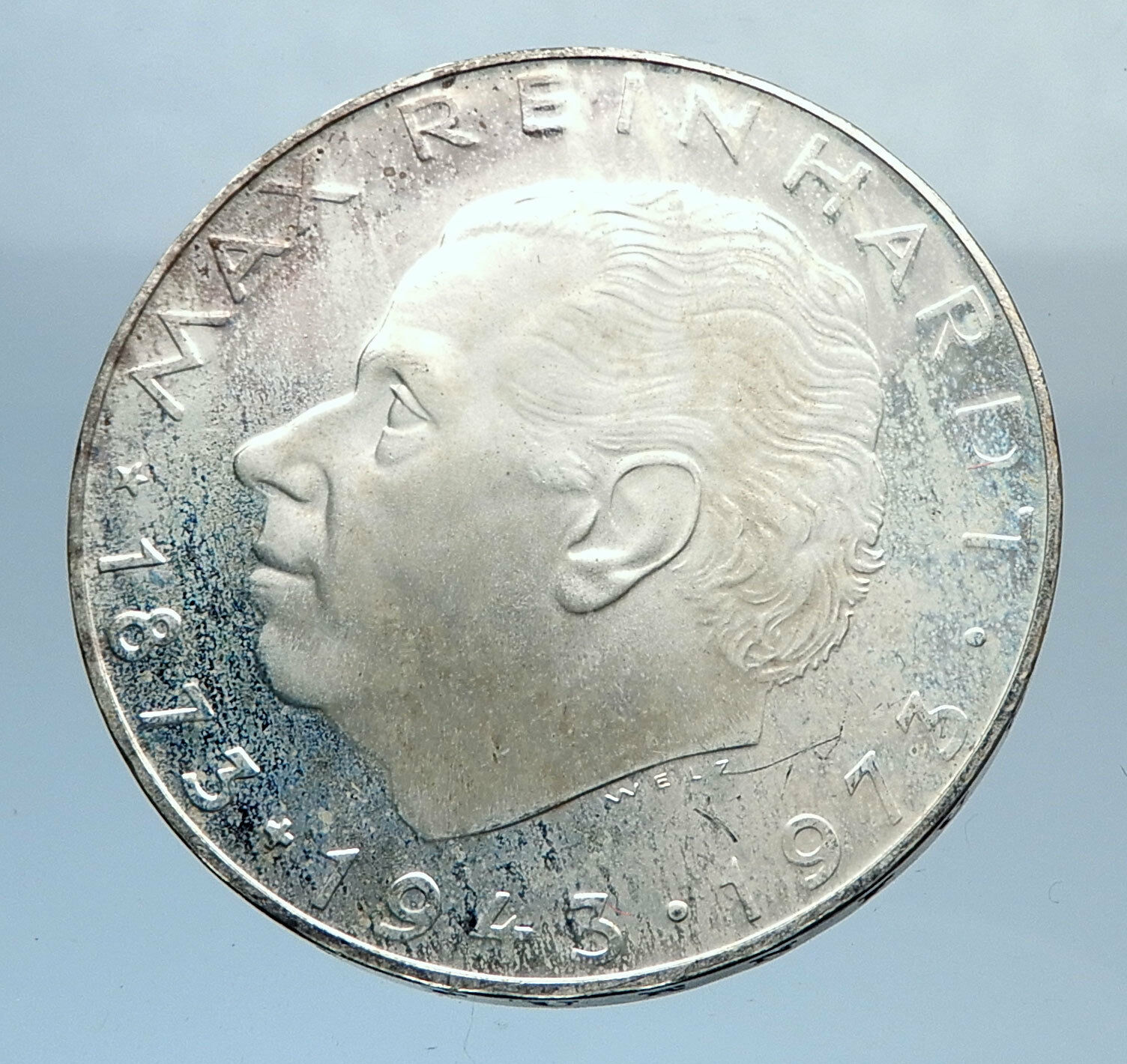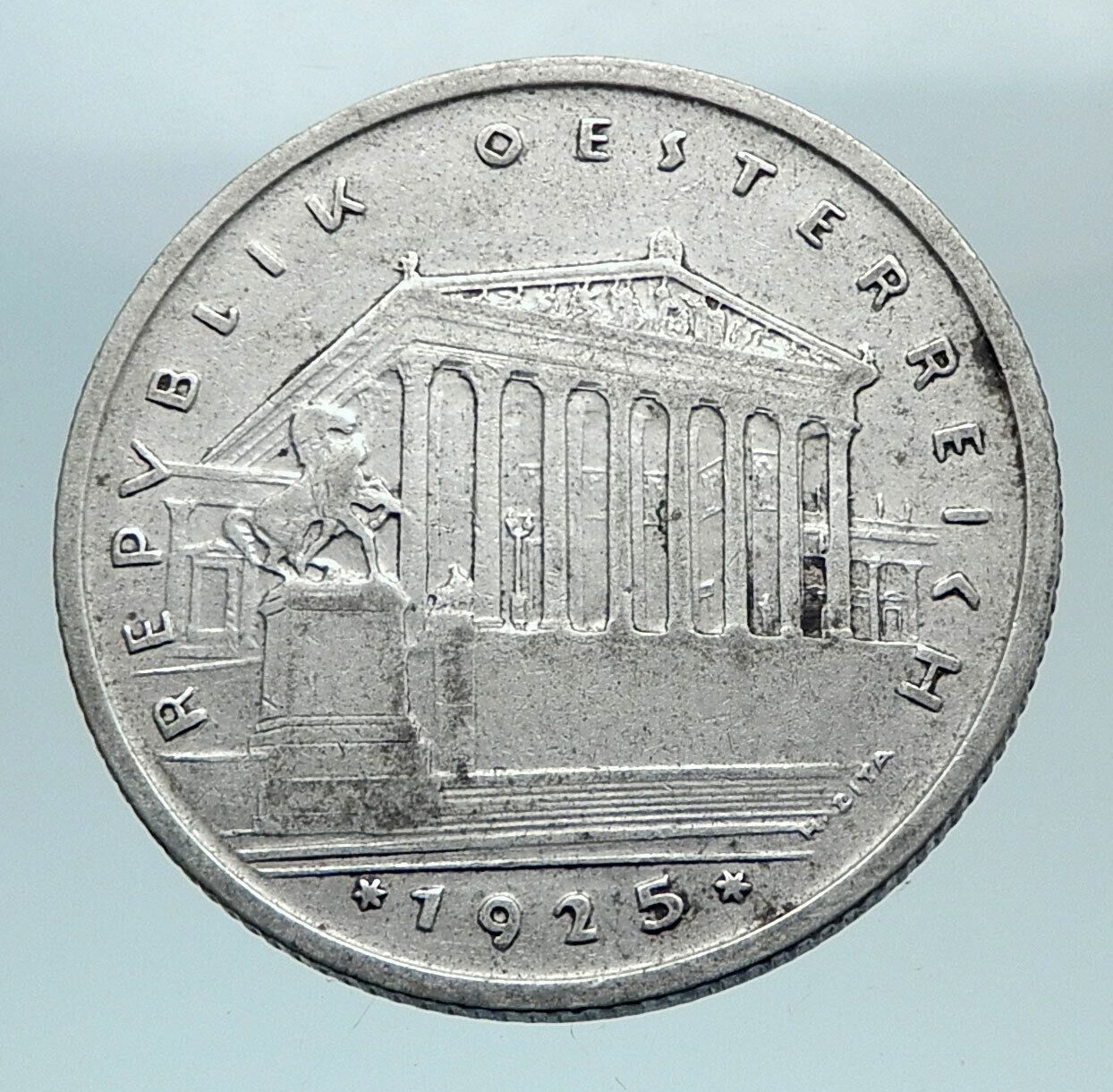|
Austria – Franz Grillparzer Commemorative Issue
1964 Silver 25 Schilling 30mm (13.00 grams) 0.800 Silver (0.3322 oz. ASW)
Reference: KM# 2895.1 Reverse Designer: Grienaeur Edge: Plain with engraved lettering
◦ ÖSTERREICH ◦ REPUBLIK 25 SCHILLING, Shields around denomination.
FRANZ GRILLPARZER 1964 GRIENAEUR, Franz Grillparzer facing 1/2 right.
You are bidding on the exact item pictured, provided with a Certificate of Authenticity and Lifetime Guarantee of Authenticity.
 Franz Seraphicus Grillparzer (15 January 1791 – 21 January 1872) was an Austrian writer who is chiefly known for his dramas . He also wrote the oration for Ludwig van Beethoven ‘s funeral. Franz Seraphicus Grillparzer (15 January 1791 – 21 January 1872) was an Austrian writer who is chiefly known for his dramas . He also wrote the oration for Ludwig van Beethoven ‘s funeral.
Franz Grillparzer was born in Vienna , Austria. His father, E.J. Grillparzer, was a severe pedant and a staunch upholder of the liberal traditions of the reign of Joseph II , and was an advocate of some standing. His mother, Anna Franziska, was a nervous, highly-strung woman who belonged to the well-known musical family of Sonnleithner.
His father destined Grillparzer for the legal profession, and, after a desultory education, Grillparzer entered the University of Vienna in 1807 as a student of jurisprudence . Two years later his father died, leaving the family in difficult circumstances. After obtaining his degree from the university in 1811, Franz first became a private tutor for a civil service as a clerk at the Imperial and Royal Hofkammer (Exchequer) in Austria. In 1821, he unsuccessfully applied to the position of scribe at the Imperial Library, and later that same year, he was relocated to the Ministry of Finance. In 1832, he became director of the archives at the Imperial and Royal Hofkammer, a position he held until his retirement in 1856. Grillparzer had little capacity for an official career and regarded his position merely as a means of independence.
From early youth, Grillparzer displayed a strong literary impulse. He devoted especial attention to the Spanish drama , and nearly all his writings bear marks of the influence of Calderón . His autobiography, which was written in 1853 and brings down the narrative of his life to 1836, is a model of clear, simple, and elegant prose, and it throws much interesting light both on his personal character and on the tendencies of his time. Among his posthumous writings are many fragments of literary, philosophic, and political criticism, all of them indicating a strong and independent spirit, not invariably just, but distinct, penetrating, and suggestive.
It is characteristic of him that he expresses extreme dislike of Hegel ‘s philosophy on the ground that its terms are unintelligible. On the other hand, he gives evidence of careful and sympathetic study of Kant . Of modern literary critics, Gervinus was most repugnant to him, mainly because of the tendency of this writer to attribute moral aims to authors who created solely for art’s sake. He rather maliciously says that Gervinus had one advantage and one disadvantage in writing his history of German literature , – the advantage of common sense, the disadvantage of knowing nothing of his subject.
Of a quiet contemplative nature, Grillparzer shunned general society. He never married. To a stranger he seemed cold and distant, but in conversation with any one he liked his real disposition revealed itself; his manner became animated, his eyes brightened, and a sarcastic but not ill-natured smile would play upon his lips. It was one of his sayings that the art of writing poetry can neither be taught nor learned, but he also held that inspiration will not visit a poet who neglects to make himself master of his subject. Hence before writing a play he worked hard, striving to comprehend the spirit of the age he wished to represent. He was exceedingly fond of travel, and at different times visited all the leading European countries.
After 1840, when his solitary comedy was rejected by the public, he almost passed from the memory of his contemporaries. Fortunately for him, his admirer Heinrich Laube settled in Vienna in 1849 as artistic director of the court theatre. By and by Laube reintroduced on the stage some of Grillparzer’s forgotten works, and their success was immediate and profound. To his own surprise, Grillparzer became the most popular author of the day; he was ranked with Goethe and Schiller, and lauded as the national poet of Austria. On the eightieth anniversary of his birthday all classes from the court downwards united to do him honour; never, probably, did Vienna exert herself so much to prove her respect for a private citizen.
He was buried with an amount of ceremony that surpassed even the pomp displayed at Klopstock ‘s funeral. He was originally buried in the Währinger Cemetery in Vienna, now known as Schubertpark. He now lies in Hietzinger Friedhof.
For his historical tragedy King Ottokar’s Fortune and End (German: König Ottokars Glück und Ende , 1823, but owing to difficulties with the censor , not performed until February 19, 1825), Grillparzer chose the conflict of Otakar II of Bohemia with Rudolph I of Germany . It appealed strongly to the patriotic sympathies of Vienna, dealing as it does with one of the proudest periods of Austrian history, the founding of the House of Habsburg . With an almost modern realism he reproduced the medieval setting of the play, at the same time not losing sight of the needs of the theatre. It cannot be said that the materials of the play are welded into a compact whole, but the characters are vigorously conceived, and there is a fine dramatic contrast between the brilliant, restless, and unscrupulous Ottokar and the calm, upright, and ultimately triumphant Rudolf. Through Ottokar’s fall, it is controversially argued that Grillparzer again preached the futility of endeavour and the vanity of worldly greatness.
A second historical tragedy, A faithful Servant of his Lord (German: Ein treuer Diener seines Herrn, 1826, performed 1828), attempted to embody a more heroic gospel; but the subject of the superhuman self-effacement of Bankbanus before Duke Otto of Meran proved too uncompromising an illustration of Kant ‘s categorical imperative of duty to be palatable in the theatre. It brought down upon the author a storm of abuse from the liberals, who accused him of servility. On the other hand, the play displeased the court, and its presentation was stopped. It hardly deserved to be made the subject of so much contention, for it is one of the least powerful of Grillparzer’s later dramas.
With these historical tragedies began the darkest ten years in the poet’s life. They brought him into conflict with the Austrian censor – a conflict which grated on Grillparzer’s sensitive soul, and was aggravated by his own position as a servant of the state. In 1826, he paid a visit to Goethe in Weimar , and was able to compare the enlightened conditions which prevailed in the little Saxon duchy with the intellectual thraldom of Vienna.
To these troubles were added personal worries. In the winter of 1820-1821, he had met and fallen in love with Katharina Fröhlich (1801-1879), but whether owing to a presentiment of mutual incompatibility, or merely owing to Grillparzer’s conviction that life had no happiness in store for him, he shrank from marriage. Whatever the cause may have been, the poet was plunged into an abyss of misery and despair to which his diary bears heart-rending witness; his sufferings found poetic expression in the cycle of poems bearing the significant title Tristia ex Ponto (1835).
Although Grillparzer was essentially a dramatist, his lyric poetry is in the intensity of its personal note hardly inferior to Lenau ‘s; and the bitterness of his later years found vent in biting and stinging epigrams that spared few of his greater contemporaries. As a prose writer, he has left one powerful short story , Der arme Spielmann (1848), and a volume of critical studies on the Spanish drama, which shows how completely he had succeeded in identifying himself with the Spanish point of view.
Grillparzer’s brooding, unbalanced temperament, his lack of will-power, his pessimistic renunciation and the bitterness which his self-imposed martyrdom produced in him, made him peculiarly adapted to express the mood of Austria in the epoch of intellectual thraldom that lay between the Napoleonic Wars and the Revolution of 1848 ; his poetry reflects exactly the spirit of his people under the Metternich regime, and there is a deep truth behind the description of Der Traum, ein Leben as the Austrian Faust . His fame was in accordance with the general tenor of his life; even in Austria a true understanding for his genius was late in coming, and not until the centenary of 1891 did the German-speaking world realize that it possessed in him a dramatic poet of the first rank; in other words, that Grillparzer was no mere Epigone of the classic period, but a poet who, by a rare assimilation of the strength of the Greeks , the imaginative depth of German classicism and the delicacy and grace of the Spaniards, had opened up new paths for the higher dramatic poetry of Europe.
 Austria, officially the Republic of Austria (German: Republik Österreich), is a federal republic and a landlocked country of over 8.5 million people in Central Europe. It is bordered by the Czech Republic and Germany to the north, Hungary and Slovakia to the east, Slovenia and Italy to the south, and Switzerland and Liechtenstein to the west. The territory of Austria covers 83,879 square kilometres (32,386 sq mi). Austria’s terrain is highly mountainous, lying within the Alps; only 32% of the country is below 500 metres (1,640 ft), and its highest point is 3,798 metres (12,461 ft). The majority of the population speak local Bavarian dialects of German as their native language, and Austrian German in its standard form is the country’s official language. Other local official languages are Hungarian, Burgenland Croatian, and Slovene. Austria, officially the Republic of Austria (German: Republik Österreich), is a federal republic and a landlocked country of over 8.5 million people in Central Europe. It is bordered by the Czech Republic and Germany to the north, Hungary and Slovakia to the east, Slovenia and Italy to the south, and Switzerland and Liechtenstein to the west. The territory of Austria covers 83,879 square kilometres (32,386 sq mi). Austria’s terrain is highly mountainous, lying within the Alps; only 32% of the country is below 500 metres (1,640 ft), and its highest point is 3,798 metres (12,461 ft). The majority of the population speak local Bavarian dialects of German as their native language, and Austrian German in its standard form is the country’s official language. Other local official languages are Hungarian, Burgenland Croatian, and Slovene.
 The origins of modern-day Austria date back to the time of the Habsburg dynasty when the vast majority of the country was a part of the Holy Roman Empire. From the time of the Reformation, many Northern German princes, resenting the authority of the Emperor, used Protestantism as a flag of rebellion. The Thirty Years War, the influence of the Kingdom of Sweden and Kingdom of France, the rise of the Kingdom of Prussia, and the Napoleonic invasions all weakened the power of the Emperor in the North of Germany, but in the South, and in non-German areas of the Empire, the Emperor and Catholicism maintained control. During the 17th and 18th centuries, Austria was able to retain its position as one of the great powers of Europe and, in response to the coronation of Napoleon as the Emperor of the French, the Austrian Empire was officially proclaimed in 1804. Following Napoleon’s defeat, Prussia emerged as Austria’s chief competitor for rule of a larger Germany. Austria’s defeat by Prussia at the Battle of Königgrätz, during the Austro-Prussian War of 1866 cleared the way for Prussia to assert control over the rest of Germany. In 1867, the empire was reformed into Austria-Hungary. After the defeat of France in the 1870 Franco-Prussian War, Austria was left out of the formation of a new German Empire, although in the following decades its politics, and its foreign policy, increasingly converged with those of the Prussian-led Empire. During the 1914 July Crisis that followed the assassination of Archduke Franz Ferdinand of Austria, Germany guided Austria in issuing the ultimatum to Serbia that led to the declaration of World War I. The origins of modern-day Austria date back to the time of the Habsburg dynasty when the vast majority of the country was a part of the Holy Roman Empire. From the time of the Reformation, many Northern German princes, resenting the authority of the Emperor, used Protestantism as a flag of rebellion. The Thirty Years War, the influence of the Kingdom of Sweden and Kingdom of France, the rise of the Kingdom of Prussia, and the Napoleonic invasions all weakened the power of the Emperor in the North of Germany, but in the South, and in non-German areas of the Empire, the Emperor and Catholicism maintained control. During the 17th and 18th centuries, Austria was able to retain its position as one of the great powers of Europe and, in response to the coronation of Napoleon as the Emperor of the French, the Austrian Empire was officially proclaimed in 1804. Following Napoleon’s defeat, Prussia emerged as Austria’s chief competitor for rule of a larger Germany. Austria’s defeat by Prussia at the Battle of Königgrätz, during the Austro-Prussian War of 1866 cleared the way for Prussia to assert control over the rest of Germany. In 1867, the empire was reformed into Austria-Hungary. After the defeat of France in the 1870 Franco-Prussian War, Austria was left out of the formation of a new German Empire, although in the following decades its politics, and its foreign policy, increasingly converged with those of the Prussian-led Empire. During the 1914 July Crisis that followed the assassination of Archduke Franz Ferdinand of Austria, Germany guided Austria in issuing the ultimatum to Serbia that led to the declaration of World War I.
 After the collapse of the Habsburg (Austro-Hungarian) Empire in 1918 at the end of World War I, Austria adopted and used the name the Republic of German-Austria (Deutschösterreich, later Österreich) in an attempt for union with Germany, but was forbidden due to the Treaty of Saint-Germain-en-Laye (1919). The First Austrian Republic was established in 1919. In the 1938 Anschluss, Austria was occupied and annexed by Nazi Germany.[14] This lasted until the end of World War II in 1945, after which Germany was occupied by the Allies and Austria’s former democratic constitution was restored. In 1955, the Austrian State Treaty re-established Austria as a sovereign state, ending the occupation. In the same year, the Austrian Parliament created the Declaration of Neutrality which declared that the Second Austrian Republic would become permanently neutral. After the collapse of the Habsburg (Austro-Hungarian) Empire in 1918 at the end of World War I, Austria adopted and used the name the Republic of German-Austria (Deutschösterreich, later Österreich) in an attempt for union with Germany, but was forbidden due to the Treaty of Saint-Germain-en-Laye (1919). The First Austrian Republic was established in 1919. In the 1938 Anschluss, Austria was occupied and annexed by Nazi Germany.[14] This lasted until the end of World War II in 1945, after which Germany was occupied by the Allies and Austria’s former democratic constitution was restored. In 1955, the Austrian State Treaty re-established Austria as a sovereign state, ending the occupation. In the same year, the Austrian Parliament created the Declaration of Neutrality which declared that the Second Austrian Republic would become permanently neutral.
Today, Austria is a parliamentary representative democracy comprising nine federal states. The capital and largest city, with a population exceeding 1.7 million, is Vienna. Austria is one of the richest countries in the world, with a nominal per capita GDP of $52,216 (2014 est.). The country has developed a high standard of living and in 2014 was ranked 21st in the world for its Human Development Index. Austria has been a member of the United Nations since 1955, joined the European Union in 1995, and is a founder of the OECD. Austria also signed the Schengen Agreement in 1995, and adopted the euro in 1999.
|





 Franz Seraphicus Grillparzer (15 January 1791 – 21 January 1872) was an Austrian writer who is chiefly known for his dramas . He also wrote the oration for Ludwig van Beethoven ‘s funeral.
Franz Seraphicus Grillparzer (15 January 1791 – 21 January 1872) was an Austrian writer who is chiefly known for his dramas . He also wrote the oration for Ludwig van Beethoven ‘s funeral. Austria, officially the Republic of Austria (German: Republik Österreich), is a federal republic and a landlocked country of over 8.5 million people in Central Europe. It is bordered by the Czech Republic and Germany to the north, Hungary and Slovakia to the east, Slovenia and Italy to the south, and Switzerland and Liechtenstein to the west. The territory of Austria covers 83,879 square kilometres (32,386 sq mi). Austria’s terrain is highly mountainous, lying within the Alps; only 32% of the country is below 500 metres (1,640 ft), and its highest point is 3,798 metres (12,461 ft). The majority of the population speak local Bavarian dialects of German as their native language, and Austrian German in its standard form is the country’s official language. Other local official languages are Hungarian, Burgenland Croatian, and Slovene.
Austria, officially the Republic of Austria (German: Republik Österreich), is a federal republic and a landlocked country of over 8.5 million people in Central Europe. It is bordered by the Czech Republic and Germany to the north, Hungary and Slovakia to the east, Slovenia and Italy to the south, and Switzerland and Liechtenstein to the west. The territory of Austria covers 83,879 square kilometres (32,386 sq mi). Austria’s terrain is highly mountainous, lying within the Alps; only 32% of the country is below 500 metres (1,640 ft), and its highest point is 3,798 metres (12,461 ft). The majority of the population speak local Bavarian dialects of German as their native language, and Austrian German in its standard form is the country’s official language. Other local official languages are Hungarian, Burgenland Croatian, and Slovene. The origins of modern-day Austria date back to the time of the Habsburg dynasty when the vast majority of the country was a part of the Holy Roman Empire. From the time of the Reformation, many Northern German princes, resenting the authority of the Emperor, used Protestantism as a flag of rebellion. The Thirty Years War, the influence of the Kingdom of Sweden and Kingdom of France, the rise of the Kingdom of Prussia, and the Napoleonic invasions all weakened the power of the Emperor in the North of Germany, but in the South, and in non-German areas of the Empire, the Emperor and Catholicism maintained control. During the 17th and 18th centuries, Austria was able to retain its position as one of the great powers of Europe and, in response to the coronation of Napoleon as the Emperor of the French, the Austrian Empire was officially proclaimed in 1804. Following Napoleon’s defeat, Prussia emerged as Austria’s chief competitor for rule of a larger Germany. Austria’s defeat by Prussia at the Battle of Königgrätz, during the Austro-Prussian War of 1866 cleared the way for Prussia to assert control over the rest of Germany. In 1867, the empire was reformed into Austria-Hungary. After the defeat of France in the 1870 Franco-Prussian War, Austria was left out of the formation of a new German Empire, although in the following decades its politics, and its foreign policy, increasingly converged with those of the Prussian-led Empire. During the 1914 July Crisis that followed the assassination of Archduke Franz Ferdinand of Austria, Germany guided Austria in issuing the ultimatum to Serbia that led to the declaration of World War I.
The origins of modern-day Austria date back to the time of the Habsburg dynasty when the vast majority of the country was a part of the Holy Roman Empire. From the time of the Reformation, many Northern German princes, resenting the authority of the Emperor, used Protestantism as a flag of rebellion. The Thirty Years War, the influence of the Kingdom of Sweden and Kingdom of France, the rise of the Kingdom of Prussia, and the Napoleonic invasions all weakened the power of the Emperor in the North of Germany, but in the South, and in non-German areas of the Empire, the Emperor and Catholicism maintained control. During the 17th and 18th centuries, Austria was able to retain its position as one of the great powers of Europe and, in response to the coronation of Napoleon as the Emperor of the French, the Austrian Empire was officially proclaimed in 1804. Following Napoleon’s defeat, Prussia emerged as Austria’s chief competitor for rule of a larger Germany. Austria’s defeat by Prussia at the Battle of Königgrätz, during the Austro-Prussian War of 1866 cleared the way for Prussia to assert control over the rest of Germany. In 1867, the empire was reformed into Austria-Hungary. After the defeat of France in the 1870 Franco-Prussian War, Austria was left out of the formation of a new German Empire, although in the following decades its politics, and its foreign policy, increasingly converged with those of the Prussian-led Empire. During the 1914 July Crisis that followed the assassination of Archduke Franz Ferdinand of Austria, Germany guided Austria in issuing the ultimatum to Serbia that led to the declaration of World War I. After the collapse of the Habsburg (Austro-Hungarian) Empire in 1918 at the end of World War I, Austria adopted and used the name the Republic of German-Austria (Deutschösterreich, later Österreich) in an attempt for union with Germany, but was forbidden due to the Treaty of Saint-Germain-en-Laye (1919). The First Austrian Republic was established in 1919. In the 1938 Anschluss, Austria was occupied and annexed by Nazi Germany.[14] This lasted until the end of World War II in 1945, after which Germany was occupied by the Allies and Austria’s former democratic constitution was restored. In 1955, the Austrian State Treaty re-established Austria as a sovereign state, ending the occupation. In the same year, the Austrian Parliament created the Declaration of Neutrality which declared that the Second Austrian Republic would become permanently neutral.
After the collapse of the Habsburg (Austro-Hungarian) Empire in 1918 at the end of World War I, Austria adopted and used the name the Republic of German-Austria (Deutschösterreich, later Österreich) in an attempt for union with Germany, but was forbidden due to the Treaty of Saint-Germain-en-Laye (1919). The First Austrian Republic was established in 1919. In the 1938 Anschluss, Austria was occupied and annexed by Nazi Germany.[14] This lasted until the end of World War II in 1945, after which Germany was occupied by the Allies and Austria’s former democratic constitution was restored. In 1955, the Austrian State Treaty re-established Austria as a sovereign state, ending the occupation. In the same year, the Austrian Parliament created the Declaration of Neutrality which declared that the Second Austrian Republic would become permanently neutral.




